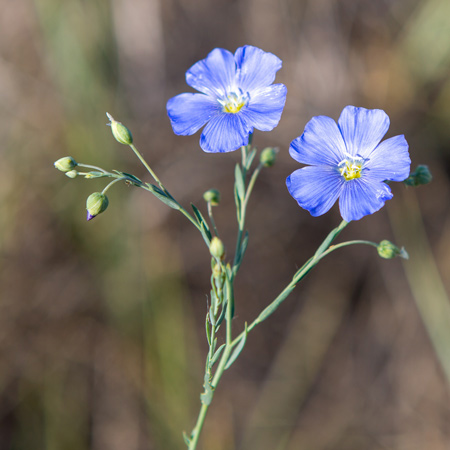Anxious to Find the Shoshone
by Yellowstone Public Radio[1]Originally aired weekdays by Yellowstone Public Radio during the Bicentennial observance of 2003-2006. Narrated by Hal Hansen. Scripts by Whit Hansen and Ed Jacobson. Produced by Leni Holliman. © … Continue reading
Blue Flax
Linum lewisii
Great Falls, Montana, 29 June 2015. © by Kristopher K. Townsend. Permission to use granted under the Creative Commons Attribution-Share Alike 4.0 International license.
Searching for Shoshones
I deturmined to go a head with a Small partey a few days and find the Snake Indians if possible after brackfast I took J. Fields Potts & my Servent [York] proceeded on . . . . I passed over a mountain on an Indian rode by which rout I cut off Several miles of the Meanderings of the River, the roade which passes this mountain is wide and appears to have been dug in maney places . . . . I Saw great maney Ibex [Bighorn Sheep].
—William Clark
Naming Dearborn’s River
we passed the entrance of a considerable river on the Stard. side; about 80 yds. wide being nearly as wide as the Missouri at that place. it’s current is rapid and water extreamly transparent . . . . this handsome bold and clear stream we named in honour of the Secretary of war calling it Dearborn’s river.—
—Meriwether Lewis
Lewis’s Blue Flax
I have observed for several days a species of flax growing in the river bottoms the leaf stem and pericarp of which resembles the common flax cultivated in the U’ States . . . . the seed are not yet ripe but I hope to have an opportunity of collecting some of them after they are so if it should on experiment prove to yeald good flax and at the same time admit of being cut without injuring the perennial root it will be a most valuable plant
—Meriwether Lewis
Changing Cottonwood Trees
we encamped on the lard. side in a small grove of narrow leafed cottonwood. there is not any of the broad leafed cottonwood on the river since it has entered the mountains.
—Meriwether Lewis
Weather Diary
State of the thermometer at rise
Weather at rise
Wind at rise
State of the Thermometer at 4 P.M. Weather at 4 P.M. Wind at 4 P.M. State of the river 60 [above 0] fair S W 67 [above 0] fair N W fallen ½ in. I set out in Search of the Indians
—Meriwether Lewis and William Clark[2]To assist the reader, the editor of this web page has omitted the date column, merged the “State of the river” columns, and spelled out some abbreviations.
Notes
| ↑1 | Originally aired weekdays by Yellowstone Public Radio during the Bicentennial observance of 2003-2006. Narrated by Hal Hansen. Scripts by Whit Hansen and Ed Jacobson. Produced by Leni Holliman. © 2003 by Yellowstone Public Radio. |
|---|---|
| ↑2 | To assist the reader, the editor of this web page has omitted the date column, merged the “State of the river” columns, and spelled out some abbreviations. |

